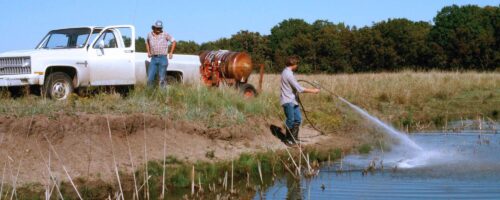Many landowners will be implementing prescribed burns this winter and spring. Prescribed burning is a land management tool that should only be used when needed and after considerable planning, taking into account numerous factors including fireguards, equipment, labor, special concerns, smoke management and fuel characteristics (loading and moisture).
A common goal with prescribed burning is brush control in pastures. Too often there is not enough consideration given to developing an adequate fuel load and determining fuel moisture for a successful prescribed burn. Without a proper understanding of fuel loading and fuel moisture, a manager risks wasting valuable time and money when attempting to control brush with a prescribed burn.
Grasses are considered one-hour fuels and are the primary carrier of fire for most prescribed burns in our area. Fuel loading of grasses is the dry weight of grass in a burn unit, usually expressed in pounds per acre. Like estimating forage production, some experienced managers are able to visually estimate this value with fair accuracy. More accurate estimates can be obtained by clipping, oven-drying and weighing. A minimum of 1,500 pounds per acre of one-hour fuel is usually needed to carry a fire. However, for controlling brush in pastures, heavier one-hour fuel loads are usually needed, depending on brush species and size. For example, 1,500 pounds of one-hour fuels will probably kill seedling Eastern red cedar, but not most taller than 2 feet. Fire intensity increases with heavier fuel loads. Fuel loading also affects other fire behavior such as ignition, rate of spread and torching (fire racing upward from the ground to treetop).
There are two kinds of fuel moisture: live and dead. Live fuel moisture is more of an issue when burning live fuel during the growing season or live fuel such as Eastern red cedar during the dormant season. Since most prescribed burns in our area are during the dormant season, it is important to know dead fuel moisture for fire control and success. Live fuel moisture can also be important during a dormant season burn. For instance, knowing live fuel moisture of Eastern red cedar will help determine its susceptibility to fire.
Fuels are classified into four categories by which they respond to changes in moisture. This response time is referred to as time lag. The four categories are:
- 1-hour fuels: up to 1/4 inch in diameter.
- 10-hour fuels: 1/4 inch to 1 inch in diameter.
- 100-hour fuels: 1 inch to 3 inches in diameter.
- 1000-hour fuels: 3 inches to 8 inches in diameter.
Examples of one-hour fuels are grass, leaves, mulch and litter. Fuel moisture in these fuels can change within one hour according to factors such as temperature, rain, humidity and shade. Conversely, larger diameter fuels such as deadfalls, brush piles, etc., take up to 1,000 hours to respond to changes in environmental factors.
Fuel moisture can be determined by clipping and immediately weighing the sample before oven drying it to a constant weight. Then the following formula can be used to determine percent fuel moisture: [(Wet Weight Dry Weight)/Dry Weight] x 100. Knowing the moisture in fuels to be burned will help managers understand the susceptibility of fuels for ignition, fire rate of spread, fire intensity and risk of spot fires, torching and crown fires, all of which are factors that need to be managed to control the fire as well as to achieve desired goals such as brush control.
Managers who understand and properly apply their knowledge of fuel loading and fuel moisture will have greater success in achieving their goals for using prescribed fire. If you would like to know more about how this information applies to you, give us a call at (580) 223-5810.


Comment